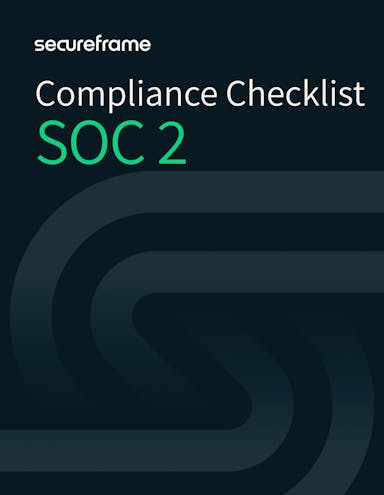
Your Step-by-Step SOC 2® Audit Checklist for Passing the Audit
Emily Bonnie
Senior Content Marketing Manager
Rob Gutierrez
Senior Cybersecurity and Compliance Manager, CISA, CCSK, CMMC RP
According to a recent System and Organization Controls (SOC) survey conducted by the American Institute of Certified Public Accountants (AICPA), the increasing awareness of the importance of IT security at third parties has led to an almost 50% increase in the demand for SOC 2® engagements.
As more customers and business partners value SOC 2 engagements as part of their third-party risk management efforts, your service organization can expect a request for a SOC 2 report.
Offering flexibility without sacrificing security rigor, SOC 2 is one of the most common security frameworks in North America. However, complying with SOC 2 requires a comprehensive audit of your organization’s systems, processes, and controls. Preparing for such an undertaking is no easy feat.
To help, we’ve created a checklist of pre-audit steps you can take to maximize your chance of passing that audit and gaining the ability to say you’re SOC 2 compliant. You can download it below or keep reading to get a detailed overview of each step.
What is a SOC 2® audit?
A SOC 2 audit is the process you undergo to see if your organization’s control set meets SOC 2 compliance requirements. SOC 2 compliance requirements consist of five trust service criteria (TSC) developed by the AICPA: security, availability, processing integrity, confidentiality, and privacy.
Previously referred to as Trust Services Principles, these criteria offer a framework for evaluating a service organization’s controls relevant to information and systems for SOC 2 compliance.
Why get a SOC 2 audit?
Passing a SOC 2 audit means you’re compliant with whichever trust services criteria you specified. This can help reassure customers that you have the necessary controls in place to protect their data, which may unblock deals, accelerate your sales cycle, and help you move upmarket.
A SOC 2 report can therefore be a powerful marketing tool, showing prospects, customers, business partners, and other key stakeholders that you’re serious about data security.
Making this commitment to data security and getting a SOC 2 report requires a significant investment of time, money, and organizational resources.
Now that we understand why SOC 2 is important, let’s take a closer look at the steps an organization must take on its SOC 2 compliance journey below.

Downloadable SOC 2 Checklist
Download this step-by-step checklist to check off the steps you’ll need to complete to achieve and maintain SOC 2 compliance to track your progress.
Your 8-step checklist to prepare for and pass your SOC 2 audit
Achieving SOC 2 compliance is not as simple as undergoing an audit. It requires you to implement controls to meet any relevant trust services criteria, identify gaps, and close them before the audit. Even when controls are in place, you must ensure your team adopts best practices for information security to maximize your chances of passing the audit. These preparations don’t happen overnight — they can take several weeks to several months.
To help simplify the process, we created an 8-step checklist for becoming audit-ready.

1. Select your report type
To start, you’ll have to select the type of SOC 2 report you want. There are two types:
- Type 1: Evaluates the design effectiveness of controls at a single point in time.
- Type 2: Evaluates the design and operational effectiveness of controls over a period of time (usually between 3 to 12 months).
In other words, Type I assesses how well you designed controls whereas Type 2 more accurately measures controls in action.
Since Type 1 only analyzes design effectiveness as of one date, it’ll be less time and resource-intensive. While Type 2 is more intensive, it carries more weight for how well your controls are designed and their operational effectiveness — both of which are more marketable. Given this increased rigor, customers typically prefer to see Type 2 reports.
Which one you select depends on what your customers are asking for, but as a general rule of thumb pick Type 2 if you care more about how well your controls function in the real world. If you’re more concerned with simply having well-designed controls and would like to save resources, pick Type 1.
2. Determine your SOC 2 audit scope and objectives
The next part of preparing for your SOC 2 audit is defining the scope and objectives.
SOC 2 audits look at infrastructure, data, people, risk management policies, and software, to name a few items. You must determine who and what within each of these categories will be subject to the audit.

Next, define what the objectives are for the in-scope systems or services. In others, what have you told your customers these systems or services will do? You can typically find this information in contracts, service level agreements, or published collateral (like your company website).
3. Select your trust services criteria
SOC 2 audits evaluate your controls within the audit scope mentioned earlier against the trust services criteria set out by the AICPA.
Recall that five trust services criteria make up the SOC 2 compliance requirements:
- Security: Protecting information and systems against unauthorized access, disclosure of information, or other mishandling/damage.
- Availability: Information and systems can meet your organization’s service objectives — such as those laid out in service-level agreements — and are available for operation.
- Processing integrity: Your systems perform their functions completely, accurately, validly, timely, and in a way that meets your organizational objectives.
- Confidentiality: You collect, use, retain, disclose, and dispose of non-personal data and information properly.
- Privacy: You collect, use, retain, disclose, and dispose of peoples’ personal information properly.
Fortunately, you don’t have to undergo an audit for all five at once. The only mandatory principle is security, and the others are recommended depending on your business. For instance, if you carry a lot of personal or sensitive data it would make sense for your organization to include privacy or confidentiality.
If you’re short on resources for the audit, pick criteria alongside security that offer the highest potential ROI or those you’re close to achieving without much additional work.
You can go for all five at once if you’re able; just keep in mind that the audit scope and cost will increase with each trust principle you add.
Recommended reading

Trust Services Criteria
4. Conduct a risk assessment
Next, you’ll need to identify potential risks to your information assets, infrastructure, software, people, procedures, and data that may affect your organization’s ability to achieve its objectives. As part of the assessment process, you’ll want to determine the likelihood that a risk could occur as well as its potential business impact. You can then rank them based on the overall risk to your organization.
This ranking will help you respond appropriately to each risk. This may involve developing or updating a business continuity plan, purchasing technology, or putting access controls or other security controls in place to mitigate the risk to an acceptable level.
5. Run an initial readiness assessment
Once you’ve implemented policies, processes, and controls to mitigate risks, you’re ready for a readiness assessment. A readiness assessment is like a practice version of the real SOC 2 audit.
While you can perform a self-assessment if you know how, bringing in an auditor or other third-party is often the better choice since they have the expertise and an outside perspective. If you work with Secureframe, we will do this readiness assessment for you.
During a readiness assessment, the auditor walks through all of your systems, processes, and controls, documenting key processes that would be in the official audit.
In the end, they issue a management letter detailing any weaknesses or deficiencies found that pertain to each trust service requirement, along with some recommendations for fixing them.
The initial readiness assessment helps you find any areas that may need improvement and gives you an idea of what the auditor will look at.
Of course, the auditor can’t help you fix the weaknesses or implement suggestions directly. This would threaten their independence — they cannot objectively audit their own work.
That part is up to you, which is where the next step comes in.
6. Perform a gap analysis and remediation
After undergoing a readiness assessment, you’ll want to perform a gap analysis and close any gaps you identify.
This involves looking at where you stand based on your initial readiness assessment, what compliance looks like in terms of your SOC 2 trust criteria, then fixing any problems that you find to bring you to SOC 2 standards before the actual audit.
Gap analysis and remediation can take a few months and may involve:
- Implementing controls
- Interviewing employees
- Training employees on controls
- Creating and updating control documentation
- Modifying workflows
Like with the readiness assessment, you may be able to outsource your gap analysis to another firm specializing in this process, although this could cost another couple thousand of dollars.
You may opt to use a compliance automation tool instead. This tool can check all of your systems and controls against SOC 2 criteria to immediately flag any misconfigurations or gaps in your compliance posture. It may also offer tailored remediation guidance that make fixing any gaps quick and easy.
7. Implement a process for continuous monitoring
After closing any identified gaps, implement a process for monitoring your controls so you can ensure they’re effective over time.
A compliance automation tool can automate this process as well. Using automation to monitor controls in real time can provide an organization with a much more dynamic view of the effectiveness of those controls and the overall security posture of the organization than manual processes alone. That is because automating data collection, analysis, and reporting where possible enables organizations to monitor a greater number of security metrics with fewer resources, higher frequencies, and larger sample sizes.
Once you feel you’ve addressed everything relevant to your scope and trust services criteria, you’re ready to request a formal SOC 2 audit.
Recommended reading

7 Benefits of Continuous Monitoring & How Automation Can Maximize Impact
8. Find a SOC 2 auditor
Since the AICPA created the SOC security guidelines, any CPA firm can perform your audit for you.
However, you’ll want to pick a CPA firm that specializes in information systems.
If you currently work with a firm that lacks CPAs with information systems knowledge and experience, your best bet is to hire a different firm for the audit. Your current firm may be able to provide some advice on preparations, but engaging with a firm that specializes in information security work will increase your chances of passing the audit.
It’s worth noting that because there’s no formal certification, hiring a CPA firm with more SOC 2 experience can bring more prestige to the end result, maximizing your reputation among customers.
That said, you will have to pay more for a more renowned firm.
Now you’re ready to undergo the audit. Let’s take a look at what the process is like below.
What is the SOC 2 audit process?
Understanding what to expect during the audit process can also help it go more smoothly. While each auditor may have a slightly different process depending on the technology they use, the size of the organization being audited, and other factors, here’s the general process:
1. The security questionnaire
Many auditing firms start by administering a questionnaire to you and your team.
This contains many questions regarding company policies, procedures, IT infrastructure, and controls.
Getting your team into good security habits as early as possible before the audit helps out here. They’ll be able to answer questions with confidence.
Recommended reading

SOC 2 vs Security Questionnaires: What’s the Difference & Which Do You Need?
2. Gathering evidence of controls
Next, auditors will ask your team to furnish them with evidence and documentation regarding the controls within your organization.
You need proof of every policy and internal control to demonstrate that things are up to par. The auditors use this as part of their evaluation to understand how controls are supposed to work.
A compliance automation tool can also automate this process so you don’t have to waste valuable time compiling evidence in spreadsheets, taking screenshots, and more.
3. Evaluation
During the evaluation, the auditors might ask the owners of each process within your SOC 2 audit scope to walk them through your business processes to understand them better.
4. Follow-Up
SOC 2 audits are intensive. As a result, auditors often uncover matters for which they need more evidence, despite all the prep work.
They may ask your team for clarification on processes or controls, or they may want additional documentation.
In some cases, if the auditor notices obvious compliance gaps that can be fixed relatively quickly, they could ask you to remedy those before proceeding.
The auditors will document their visit as well, just in case further follow-up is needed.
5. The SOC 2 report
When the audit concludes, the auditing firm will issue you a SOC 2 audit report.
There is no formal SOC 2 certification. Instead, the main portion of the report contains the auditor’s opinion regarding the effectiveness of your internal controls as they pertain to your specified trust principles.
There are a few types of opinions they may offer:
- Unmodified (or Unqualified) opinion: No material inaccuracies or flaws in systems. This is your goal.
- Qualified opinion: There are material misstatements in system control descriptions, but they’re limited to specific areas.
- Adverse opinion: There is sufficient evidence that there are material inaccuracies in your controls’ description and weaknesses in design and operational effectiveness.
Hopefully, your hard work pays off, and you get a SOC 2 report with an unmodified opinion for every trust criteria you chose.
How Secureframe can help you prepare for and pass your SOC 2 audit
Without the right technology and expertise, preparing for a SOC 2 audit will take a significant investment of time, money, and mental energy.
Secureframe’s compliance automation platform, paired with an in-house team of compliance experts, can help streamline the entire process. With Secureframe, you can:
- Automatically collect evidence, test it against SOC 2 requirements, and share with your auditor in a secure Data Room
- Continuously monitor your tech stack and get alerts for threats and non-conformities to easily maintain SOC 2 compliance year after year
- Speed up time-to-compliance for other frameworks, including ISO 27001, PCI DSS, and HIPAA
- Save time on policy creation with our library of auditor-approved policy templates
- Conduct third party risk management and vendor compliance efforts using Secureframe’s risk and vendor modules
- Get expert, end-to-end support from compliance experts and former auditors throughout the entire process
As a result of these capabilities and more, 95% of Securframe users said they saved time and resources obtaining and maintaining compliance in a survey conducted by UserEvidence.
Request a free demo today to learn more about how Secureframe can simplify SOC 2 audit preparation.
FAQs
What distinguishes a Type I SOC 2 report from a Type II SOC 2 report?
What distinguishes a Type I SOC 2 report from a Type II SOC 2 report?
A Type I SOC 2 report evaluates the design of controls at a specific point in time, while a Type II SOC 2 report assesses the design effectiveness of these controls over a period of time, usually spanning three to six months.
What are the key steps involved in a SOC 2 audit process?
The key steps in a SOC 2 audit process typically involve the following key steps:
- Planning and agreeing on a timeframe
- Requesting and reviewing a security questionnaire
- Evaluating control design and/or operating effectiveness
- Testing controls
- Gathering evidence
- Drafting the report
- Issuing findings or recommendations
What items should be on a SOC 2 audit preparation checklist?
A SOC 2 audit preparation checklist should include identifying scope and objectives, documenting control activities, assessing risks, ensuring evidence availability, conducting employee training, establishing communication channels with auditors, and reviewing previous audit findings for remediation.

Emily Bonnie
Senior Content Marketing Manager
Emily Bonnie is a seasoned digital marketing strategist with over ten years of experience creating content that attracts, engages, and converts for leading SaaS companies. At Secureframe, she helps demystify complex governance, risk, and compliance (GRC) topics, turning technical frameworks and regulations into accessible, actionable guidance. Her work aims to empower organizations of all sizes to strengthen their security posture, streamline compliance, and build lasting trust with customers.

Rob Gutierrez
Senior Cybersecurity and Compliance Manager, CISA, CCSK, CMMC RP
Rob Gutierrez is an information security leader with nearly a decade of experience in GRC, IT audit, cybersecurity, FedRAMP, cloud, and supply chain assessments. As a former auditor and security consultant, Rob performed and managed CMMC, FedRAMP, FISMA, and other security and regulatory audits. At Secureframe, he’s helped hundreds of customers achieve compliance with federal and commercial frameworks, including NIST 800-171, NIST 800-53, FedRAMP, CMMC, SOC 2, and ISO 27001.